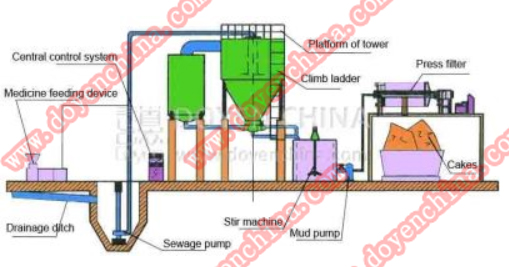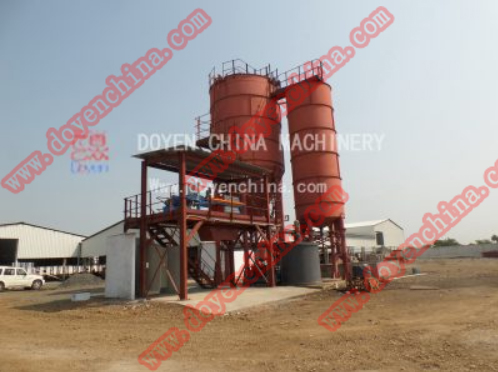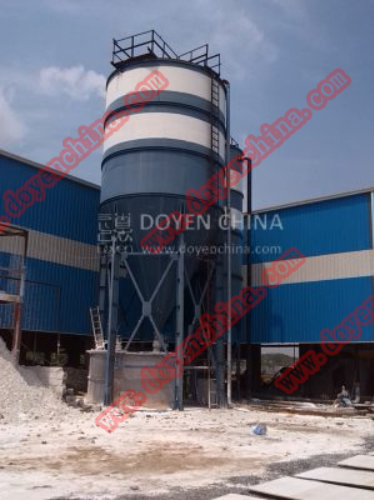

Tel:
+86-757-8633-0278
Email:doyen@doyenchina.com
Fax:+86-757-86287390
Address:Room 201, Building No. 24, Yicui Rose Garden, No. 2, Jihua 7 Road, Chancheng District, Foshan City, Guangdong Province, China 528000.
1. Hydrogen sulfide is the main cause of acute poisoning accidents in the industry
Hydrogen sulfide exists in the form of a colorless gas with the smell of rotten eggs at room temperature. It is soluble in water and can explode when the concentration in the air reaches 4.3% -45.5%. The gas is not only an irritating gas, but also an asphyxiating gas with a strong neurotoxicity. Low concentration (30-300mg/m3) can cause tearing, coughing, dizziness, headache, chest tightness, fatigue, nausea, vomiting and other symptoms after contact. Medium concentration (300-700mg/m3) can cause dizziness, headache, chest tightness, fatigue, nausea, vomiting and other prominent symptoms after exposure, and can cause limb dyskinesia, transient disturbance of consciousness, etc. At high concentrations (above 700mg/m3), it can directly act on the brain nerve center through the body’s chemoreceptors, causing respiratory paralysis or further cessation, abnormal heartbeat and further cessation, resulting in delirium, convulsions, rapid coma, etc. “Lightning-like” coma or death (above 1000mg/m3), at the same time. Accompanied by pulmonary edema. In addition, hydrogen sulfide also has a cytotoxic effect, producing symptoms similar to cyanide poisoning, which may cause illness and death after being sent to the hospital for treatment.

2. Methane is the main cause of acute poisoning accidents in the industry
Methane is a colorless and odorless gas at room temperature. It is lighter than air and can explode in the air. The gas is a simple asphyxiating gas and has anesthesia-like effect. When the air concentration reaches 25%-30%, short-term inhalation can cause dizziness, headache, chest tightness, fatigue, nausea, vomiting and other symptoms. In addition to dizziness, headache, chest tightness, fatigue, nausea, vomiting and other prominent symptoms after continued inhalation, it can cause limb dyskinesia and transient disturbance of consciousness. When inhaled in large quantities, it can directly act on the brain nerve center through the body’s chemoreceptors, causing respiratory paralysis or further stop and abnormal heartbeat and further stop, causing delirium, convulsions, rapid coma, etc., resulting in “lightning-like” coma or death.
Acute poisoning caused by sewage treatment tanks and construction pumped wells is not only caused by the above-mentioned two gases escaping from sewage due to daily accumulation and agitation, but also due to lack of oxygen due to the above-mentioned gases.

3. Carbon dioxide is the secondary cause of acute poisoning accidents in the industry
Carbon dioxide exists as a colorless and odorless gas at room temperature. It is heavier than air and non-flammable and explosive. The gas is a simple suffocating gas with a content of 0.03% in natural air. It has an excitatory effect on the respiratory center at low concentrations, and inhibits the respiratory center at high concentrations. Acute poisoning is often accompanied by hypoxia. Therefore, the daily so-called carbon dioxide poisoning is not simple, but it is actually caused by hypoxia. Short-term inhalation of high concentrations can cause dizziness, headache, chest tightness, fatigue, nausea, vomiting and other symptoms. Continued inhalation can cause limb dyskinesia, temporary disturbance of consciousness, etc. When inhaled in large quantities, it can directly act on the brain nerve center through the body’s chemoreceptors, causing respiratory paralysis or further stop and abnormal heartbeat and further stop, resulting in delirium, convulsions, and rapid coma, etc., leading to death.
4. Cyanide and hydrogen cyanide are the secondary causes of acute poisoning accidents in the industry
In cyanide, sodium cyanide (mountain) and potassium cyanide are highly toxic substances; potassium ferrocyanide (yellow blood salt), ferrous ferrocyanide (Prussian blue), potassium ferricyanide (red blood salt) It has low toxicity, but it releases highly toxic hydrocyanic acid when it encounters acid; cyanide generally does not cause poisoning except for ingested eyes or damaged skin. Hydrocyanic acid is a colorless, bitter almond-flavored liquid that emits highly toxic vapors. Hydrogen cyanide has a colorless, bitter almond-like gas at room temperature. All inorganic cyanide substances are a kind of suffocating substances of strong blood poison. Very small amounts can cause dizziness, headache, chest tightness, fatigue, nausea, vomiting and other symptoms. Severe poisoning can cause immediate death. Inhalation of high concentration hydrogen cyanide gas (300mg/kg) for a short time died immediately.
5. Arsenide and arsine are the secondary causes of acute poisoning and safety production accidents in this industry
Arsenic trioxide (arsenic) is a highly toxic substance, arsenic pentoxide, arsenic trisulfide (orpiment), arsenic disulfide (realgar) and other low toxicity, arsenic compounds release highly toxic arsenic in the presence of acid hydrogen. The highly toxic arsenic generally does not cause poisoning except for inadvertently in the eyes or damaged skin. Arsenide is a colorless, garlic-smelling gas at room temperature. Arsenic is a kind of strong hemolytic poison, which mainly causes kidney damage, and also damages the heart, liver and skin. Inhalation of a small amount of arsine can cause dizziness, headache, chest tightness, fatigue, nausea, vomiting and other symptoms. Severe poisoning can cause immediate death. Short-term inhalation of high-concentration arsine gas (250ppm) immediately died, and inhalation of 25-50 ppm for 30 minutes also caused death.
6. Ammonia is the secondary cause of acute poisoning and safety production accidents in this industry
Ammonia exists in the form of colorless, smelly urine, and irritating gas at room temperature. It mainly causes upper respiratory tract irritation and corrosion. It severely leads to chemical pneumonia, pulmonary edema, and even acute lung hemorrhage, pneumothorax, emphysema, etc. , The skin also has burn damage. Inhalation of a small amount of ammonia gas (above 100mg/m3) can cause upper respiratory tract irritation symptoms, such as coughing, watery tears, chest tightness, fatigue, nausea, vomiting, laryngeal edema, dyspnea, etc., severe (1750-4500mg/m3) Chemical pneumonia, pulmonary edema, and death may occur immediately.
Among the dangers of sewage treatment, the harmful effects of toxic and harmful gases in the sewage treatment tank are relatively great. More than 80% of accidents occur in the sewage tank or related operations, especially in summer, the season when sewage treatment accidents are high. Be very careful and pay attention to your own safety.

Doyen specializes in providing belt press equipment for the Southeast Asian market. Welcome to visit our workshop and formulate a more scientific plan based on the actual situation of your company. Welcome to visit joyce@doyenchina.com or visit https://www.doyenchina.com.
Jan-24-2021
admin

 +86-757-8633-0278
+86-757-8633-0278 doyen@doyenchina.com
doyen@doyenchina.com Sitemap
Sitemap